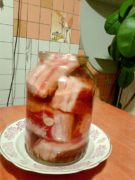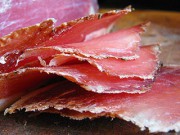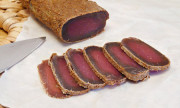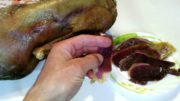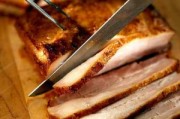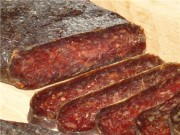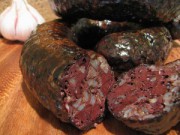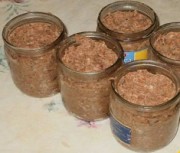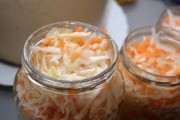Biltong - a recipe for making jerky at home.
Perhaps biltong is one of the few dishes that needs to be cooked in the heat and sun. This dish comes from Africa. It was invented by residents of Namibia, South Africa and other African countries with a hot climate, where many insects fly in the air, trying to land on meat. The biltong recipe was invented in order to somehow preserve the meat from spoilage.
As you know, ordinary people did not have refrigerators before. Over time, this one is easy meat drying recipe spread throughout the world.
This method of preparing meat is mentioned in the adventure novel “The Diamond Thieves” by Louis Boussenard, where he describes the entire drying process. Thus, the Bechuanas could wither an entire elephant and provide themselves with food for a long time.
Biltong or jerky is a high calorie food. To get juicy meat, it is dried in thick strips. Cutting from such a piece will decorate any holiday table. Thin strips of biltong are a great find for hiking. When going on a long trip, you don’t need to take stewed meat with you - take biltong. And if it is cut into thin strips, it is the best snack for beer, wine or vodka.
Content
What is biltong?

The word biltong is of Dutch origin, coming from two words: bil - hip part, tong - stripes, ribbons. This dish is nothing more than meat cut into strips and marinated in various spices, and then dried. In Russian, the dish would be called “Balyk” or, simply, “Delicious dried meat”, “Meat for beer”. There are many varieties of biltong: it all depends on the spices that are used to marinate it, the thickness of the strips and the drying method.
How to cook biltong
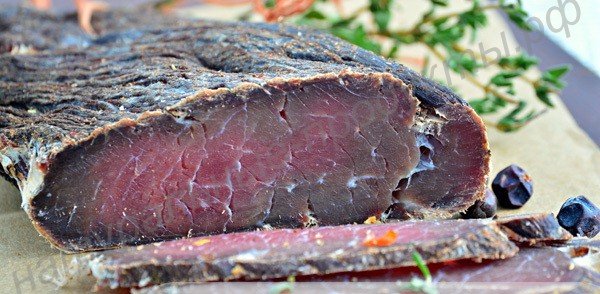
To prepare this delicious dish, any meat (chicken, turkey, beef, horse meat) is suitable, except pork. Pork takes much longer to salt. Before cutting, poultry fillet (chicken, turkey) should be kept in the freezer for a while until it begins to freeze, so that it is better cut into thin strips.
Biltong can be prepared from thick strips of meat - it will be juicier, and from thin strips of meat - it cooks faster, but the meat turns out a bit dry. Each cooking method has its own advantages.
To prepare biltong, you can take various cuts of meat, both from the thick end and from the thin end. The main thing is that it is fresh, elastic, pink from a young animal, and preferably there are fewer veins. If there are still films and cores, we cut them out. Wash the meat prepared in this way, dry it and begin cooking.
It is better to take whole spices, not ground, and grind them immediately before use. Fry the coriander in a dry frying pan, making sure it doesn’t burn. Remove from the stove and let cool. Then grind the coriander together with black pepper in a coffee grinder or crush it through the film with a rolling pin. Mix all the spices prepared for pickling along with salt.
To prepare thin slices of meat for long-term storage and for beer, cut it along the grain into strips 20-25 cm long, 5-7 cm wide, 1 cm thick, or even thinner. Cross cutting is also allowed if you want to speed up the cooking process. In this case, the finished product will be less tough. And if you beat the chopped pieces a little, the meat will cook even faster.
For juicy biltong for the festive table, we cut strips of meat 3 cm thick, but such meat cannot be stored for a long time, it needs to be cooked before you are going to eat it.

Rub the pieces of meat on all sides with the pickling mixture, rub it into the meat and as if massaging it. This is necessary so that the meat is better saturated with spices. Sprinkle it with apple or grape vinegar on both sides and let it soak.
Then, place the pieces of meat tightly in glass or enamel dishes (avoid metal) and cover with cling film. We put pressure on top of the meat and keep it in the refrigerator. A plastic bottle with water can be used as oppression. Juice will be released in the dishes - do not drain it. After 6 hours, turn the meat over to the other side, compact it again and put pressure on top. So marinate the workpiece for 12 hours. This time is not enough for salting meat, but vinegar and the fact that the slices are thin speeds up the process.
After 12 hours, remove the meat from the resulting brine. It turns brownish in color, indicating its readiness.
Then, dip the meat in diluted vinegar for 5 minutes, wash it from salt and spices, take it out and squeeze it well. If the salt is not washed off the meat, the finished biltong will be very salty. We hang the meat for drying.
We dilute vinegar like this: take 6% wine vinegar and dilute it with water in a ratio of 1:6, if you have 9% vinegar, then dilute it 1:9. We make sure that the proportions are accurate, otherwise the finished meat will taste unpleasant and sour.
Thin strips of dried meat are ready in 1-2 days.
To cut biltong thinly, special kitchen scissors are used, but a thick piece of meat for the festive table is cut with a sharp knife.
1 kg of fresh meat produces 300 g of biltong.
How to prepare a pickling mixture for drying meat

For 1 kg of meat you need to take: 2 tbsp. tablespoons of coarse rock salt (approximately 45-50 g), 1 tablespoon of ground coriander, 1 heaped teaspoon of sugar, 1 teaspoon of black peppercorns (1.5-2 teaspoons is possible), ground red pepper to taste, 2 g baking soda.
Ideally, brown cane sugar is used for the pickling mixture, but you can use the common one here - from beets. You can take coriander with a heap or without a heap - you decide for yourself, it’s not for everyone. In some recipes it is recommended to take less salt (30 g) and add hot red ground pepper - also not for everybody. The main thing is that the salt should not be iodized, otherwise the meat will have a strong iodine taste. Some recipes recommend sea salt for salting meat.
In our recipe, the main seasoning is coriander. In food factories, in order for the finished product to acquire a beautiful pink tint, they add food nitrate, but we won’t add it - we don’t need extra nitrates.
Depending on the taste you prefer, you can prepare your own pickling mixture and add the spices you like.In some recipes, allspice, dried thyme, dried basil are added, but you still need to remember the main thing - there should be the amount of salt and coriander given above.
Drying meat
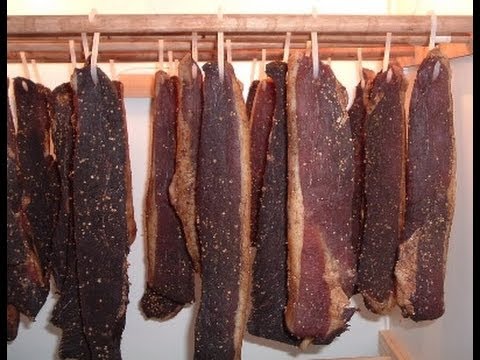
To hang meat, use nylon twine or stainless hooks.
We hang the strips soaked in spices, salt and vinegar in a well-ventilated area at room temperature 20-25°C; if the temperature is higher, it’s okay, drying is considered normal at temperatures up to 40°C. It is only important that flies and other insects do not get on the meat.
If the area where you live does not have the same temperature as indicated above, then it is not at all necessary to buy special dryers. Meat can be dried at any temperature in a well-ventilated area. It could even be your kitchen.
In the summer, when it’s hot, you can dry the meat on the balcony by hanging it. The balcony should be well ventilated. The windows or the meat itself are covered from flies with a net.
To speed up drying under normal conditions or in places with high humidity, special devices with heating and ventilation are used. Thin slices are ready in a day, thicker slices in a couple of days.
You can also use the oven for drying by hanging strips of meat in it and turning it on at 70°C. Better yet, turn on the oven only for airflow without heat. The oven door must be open. If we dry it in the oven, we need to be careful not to dry out the meat. We determine the degree of readiness ourselves. Some people like their slices dry, while others think they should be soft in the middle.
Meat for beer or for long-term storage must be dried until the pieces are dry, but care must be taken that the meat does not dry out, that is, does not begin to break.Meat is considered ready if it is well dried, but remains plastic, has acquired an almost black color in the whole piece, and remains richly scarlet when exposed to light.
To cut biltong for the holiday, take thick slices, dry them for so long that the meat dries but remains soft, cut thinly with a sharp knife and cool for 2-3 hours before serving.
How to prepare biltong the South African way
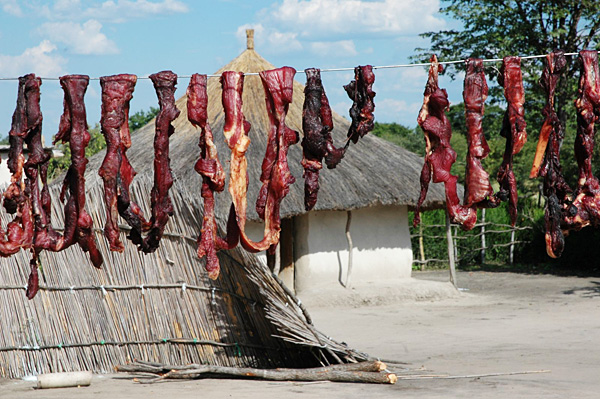
In Africa, biltong is prepared from the meat of freshly slaughtered elephants, antelopes, buffalos, and ostriches.
Namibian pickling mixture (Okahanda)
For 1.5 kg of meat take: 60 g salt, 2 g pepper, 15 g sugar, 3 g soda, 15 g coriander.
They say that in Namibia, locals dry meat by hanging it directly on trees. It is also known from adventure literature that they dry it in plywood dryers. This is a closed box, 1 m high, 0.5 m wide, with holes in the lid and on the sides. Inside the box, in its lower part, an ordinary 60 W electric light bulb is inserted; in the upper part of the box, pieces of marinated meat are hung on hooks so that they do not touch. The light is on all the time, the heat rises and the meat dries. This dryer can accommodate 1-3 kg of meat.
How to store jerky
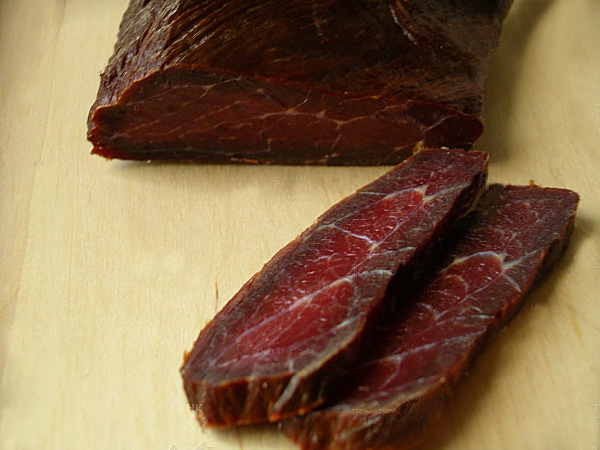
Biltong is stored in the usual way, in a paper or linen bag. But you can’t store it like this for long – up to 1 week, since it continues to dry out. To prevent it from further drying out, wrap the finished meat in cling film and store it in the refrigerator. But biltong cannot be stored in the refrigerator for more than 2 months. For longer storage, place the dried pieces of meat in the freezer.



